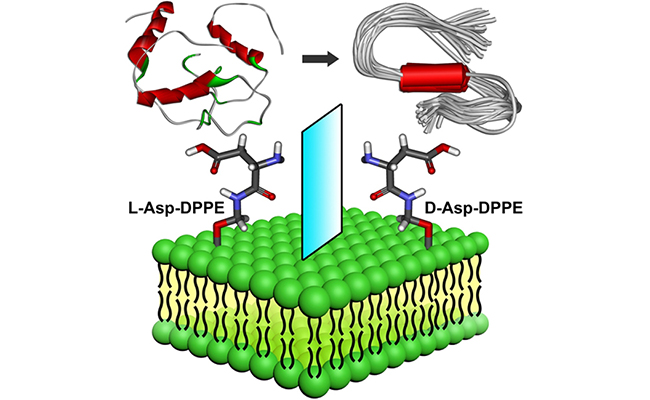Alzheimer's disease (AD) is one of the biggest global public health challenges. However, the pathogenesis of AD is still unclear.
A number of studies showed that cell membranes play crucial roles in the progress of AD, particularly amyloid-β (Aβ) accumulation. Therefore it's essential to investigate the effect of biological membranes on amyloid formation.

Molecular chirality mediated amyloid formation on phospholipid surfaces (Image by WANG Xue)
Recently, research groups led by Prof. QING Guangyan and Prof. LI Guohui from the Dalian Institute of Chemical Physics (DICP) of the Chinese Academy of Sciences designed and prepared a pair of chiral amino acid-modified phospholipids, showing remarkable influence of molecular chirality of chiral liposomes on the amyloid formation.
The researchers found that the self-assembled L-liposomes slightly inhibited Aβ(1-40) nucleation process but could not affect oligomer elongation process. By comparison, the D-liposomes strongly inhibited both the nucleation and elongation processes of Aβ(1-40).
Chiral liposomes not only had good biocompatibility but also could rescue Aβ(1-40) aggregation induced cytotoxicity with significant chiral discrimination, in which the cell viability was higher in the presence of D-liposomes.
Meanwhile, The scientists revealed the binding site, binding manners and driving force between Aβ(1-40) and chiral phospholipid surfaces through detailed molecular dynamics simulations.
These findings expanded the research from artificial chiral surfaces to real chiral phospholipid surfaces, providing a deeper and real insight to understand the crucial amyloidosis process from the perspective of chiral biointerface.
Liposomes have convincing biocompatibility, and the convergence of liposomes with non-natural D-amino acids as amyloid inhibitors have great application prospects in the AD early prevention and treatment, which points out a clear direction for the development of liposome-based inhibitors.
The study was published in Chemical Science. It was supported by the National Natural Science Foundation of China, the Start-up Fund of the Innovation Special Zone Group of DICP, and the Xingliao Elite Program. (Text by WANG Xue)